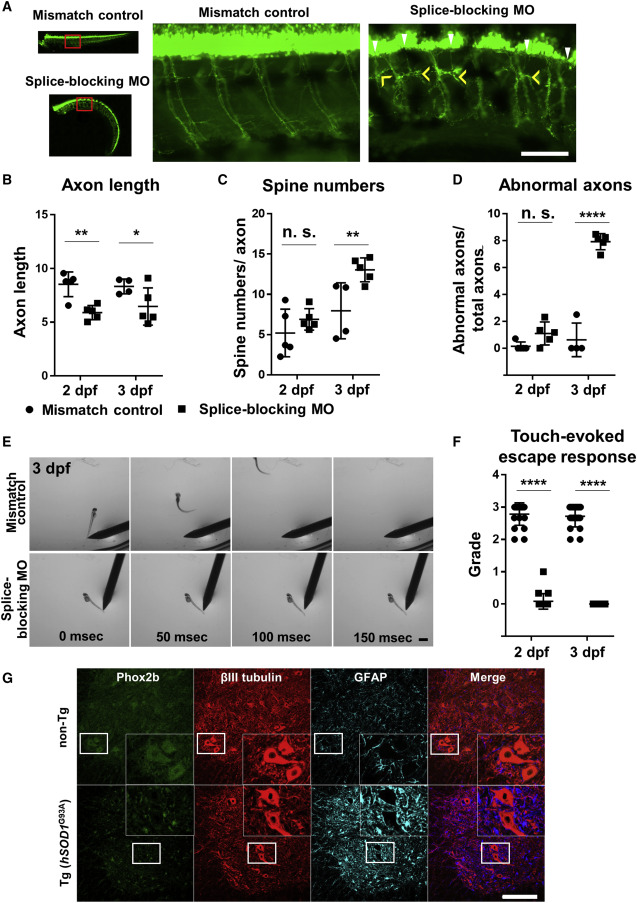Fig. 7 (A) Zebrafish embryos injected with a splice-blocking MO for phox2b (lower column) have shorter spinal axons and increased axonal spines compared with those injected with mismatch control MO (upper column) at 3 dpf. In zebrafish injected with the splice-blocking MO, axonal spines also became thicker (yellow arrow heads), and abnormal ectopic axons (white arrow heads) were detected. Scale bar, 100 μm. (B) Quantitative analysis of Venus-positive spinal axon length. Spinal axon length was normalized to total spinal cord length. Zebrafish embryos injected with the splice-blocking MO exhibited significantly shorter spinal axons at 2 dpf than zebrafish embryos injected with mismatch control MO. n = 4–5 animals per group. Two-way ANOVA with post hoc Tukey HSD tests. ∗∗p < 0.01, ∗p < 0.05. (C) Quantitative analysis of Venus-positive axonal spine numbers. Zebrafish embryos injected with the splice-blocking MO exhibited significantly more spines per axon at 3 dpf than zebrafish embryos injected with mismatch control MO. The average spine numbers of 13–15 axons per animal was compared in 4–5 animals per group. Two-way ANOVA with post hoc Tukey HSD tests. ∗∗p < 0.01. (D) Quantitative analysis of Venus-positive abnormal axons. Axons connecting to ectopic axons or with spines as thick as or thicker than the caudal MNs were defined as abnormal. Zebrafish embryos injected with the splice-blocking MO had significantly more abnormal axons at 3 dpf than zebrafish embryos injected with mismatch control MO. n = 4–5 animals per group. Two-way ANOVA with post hoc Tukey HSD tests. ∗∗∗∗p < 0.0001. (E) The effects of phox2b KD on motor functions were assessed by comparing touch-evoked escape responses at 3 dpf. Zebrafish embryos injected with the splice-blocking MO (lower column) were unresponsive to tail stimulation. Scale bar, 1000 μm. (F) Quantitative analysis of touch-evoked escape response grade. At 2 dpf, no zebrafish embryos injected with the splice-blocking MO swam away after tail stimulation, whereas a few reacted by tail flicking. At 3 dpf, all were unresponsive to stimulation. n = 20 per treatment group under triplicates for each animal. Two-way ANOVA with post hoc Tukey HSD tests. ∗∗∗∗p < 0.0001. See also Figure S4. (G) In hSOD1G93A Tg rats, Phox2b (green) expression was reduced in βIII tubulin (red) positive lumbar spinal cord anterior horn cells compared with the non-Tg rats. GFAP (glial fibrillary acidic protein, cyan) positive astrocytes show very faint Phox2b staining in non-Tg rats. The figure's lower end represents the ventral side. Scale bar, 200 μm.
Image
Figure Caption
Figure Data
Acknowledgments
This image is the copyrighted work of the attributed author or publisher, and
ZFIN has permission only to display this image to its users.
Additional permissions should be obtained from the applicable author or publisher of the image.
Full text @ Stem Cell Reports

